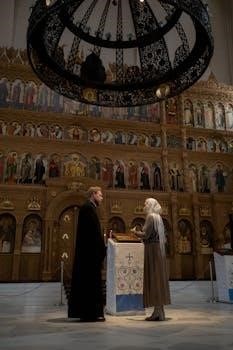The sacraments provide guaranteed moments to encounter God, strengthening our bond with Jesus and the Church․ These sacred rituals, instituted by Christ, offer a pathway to understand, celebrate, and experience divine grace․ They are a tangible way to meet Jesus․
The Concept of Sacraments as Encounters with Jesus
The sacraments are not mere symbolic gestures; they are profound encounters with the living Christ; Through these sacred rites, Jesus makes his presence known in a tangible and powerful way․ Each sacrament is a privileged moment where believers can experience the transformative grace of God․ This encounter goes beyond intellectual understanding, touching the very core of our being․ The sacraments are a means by which we meet Christ personally and experientially, not just as a historical figure, but as a living and active force in our lives․ They are the definitive way that Jesus remains present to the Church and the world today․ These encounters deepen our relationship with Jesus, allowing us to receive his healing, forgiveness, and love․ They are the channels through which the fruits of Christ’s Redemption are given to us, offering a pathway to spiritual growth and transformation; The sacraments are the way the Church manifests the unity of the people of God in a concrete way, reminding us that we are part of a community of faith centered on Christ․

Understanding the Sacraments
Sacraments are sacred rituals, instituted by Christ, that provide grace․ They are encounters with Jesus, strengthening our relationship with God and the Church․ These rites offer a path to spiritual transformation․
Sacraments as Instituted by Christ
The sacraments are not merely symbolic gestures; they are powerful encounters with Jesus Christ, established by Him as a means of conveying divine grace․ As the primordial sacrament, Christ makes God visible and present, continuing His saving work through the Church․ These sacred rites, rooted in the actions and words of Jesus, are not simply human creations but divinely ordained channels of grace․ They are a way for believers to connect with Christ’s life, death, and resurrection․ Through these sacraments, the Church perpetuates Jesus’ mission, offering a path to meet Him and receive the benefits of His redemptive sacrifice․ Each sacrament is a unique opportunity to experience the transformative power of Christ, as He intended when He instituted them; These are not just rituals but living encounters․
The Three Dimensions of Sacraments⁚ Understanding, Celebrating, and Grace
The sacraments are experienced through three interconnected dimensions⁚ understanding, celebrating, and grace․ Understanding involves grasping the theological meaning and historical context of each sacrament, exploring their origins and significance within the Church․ Celebrating refers to the actual participation in the sacramental rites, engaging in the rituals and prayers that make up each ceremony․ Grace, the most vital dimension, represents the divine gift received through the sacraments, transforming individuals and deepening their relationship with God․ These three dimensions are essential for a full sacramental experience, where intellectual understanding, communal worship, and personal transformation meet․ The sacraments are not just events; they are opportunities to encounter Christ, receiving His grace through understanding and celebration, enriching spiritual lives․ This integrated approach allows one to fully benefit from these sacred encounters․

Exploring the Seven Sacraments
The seven sacraments, instituted by Christ, are Baptism, Eucharist, Confirmation, Reconciliation, Anointing of the Sick, Holy Orders, and Matrimony․ Each offers unique grace and a special encounter with Jesus․

Baptism⁚ Initiation into the Church
Baptism, the first sacrament of initiation, marks the beginning of our Christian journey, cleansing us from original sin and uniting us with Christ․ It is through water and the Holy Spirit that we are reborn into a new life as members of the Church․ This sacrament is not just a symbolic act but a real encounter with Jesus, who invites us to be part of his family․ As we are immersed in the waters of baptism, we also become part of the worldwide community of believers․ It is the foundation upon which all the other sacraments build, a powerful initiation into the life of grace and faith․ Through baptism, we receive the Holy Spirit and are called to live a life reflecting Christ’s teachings and love․ It provides a new beginning, offering a fresh start with God․
Eucharist⁚ The Central Sacrament
The Eucharist, often called Holy Communion, is the heart of the Catholic faith, considered the most central of all sacraments․ It is here that we encounter Jesus in the most intimate way, through the consecrated bread and wine, which become his Body and Blood․ This sacrament is not merely a symbol; it is the real presence of Christ among us․ As we receive the Eucharist, we are nourished spiritually, strengthened in our faith, and unified as the Body of Christ․ It reminds us of Jesus’s sacrifice on the cross and his constant love․ It deepens our relationship with him and calls us to live out our lives with a greater sense of purpose․ The Eucharist is a powerful source of grace, inviting us into a profound communion with God․
Confirmation⁚ Strengthening of Faith
Confirmation is a sacrament that deepens our connection with the Holy Spirit, strengthening the grace received at Baptism․ It’s a personal affirmation of our faith, where we consciously choose to embrace the Christian life․ Through the laying on of hands and anointing with sacred oil, we receive the gifts of the Holy Spirit, empowering us to live as true witnesses of Christ․ This sacrament is not a graduation from faith but a call to more active participation in the Church․ Confirmation equips us to better understand and defend our beliefs, living out our faith in the world․ It strengthens our commitment to God and to his people, empowering us to be active members of the Church․
Reconciliation⁚ Forgiveness and Healing
The Sacrament of Reconciliation, often called Confession, is a powerful encounter with God’s mercy and forgiveness․ It provides a means of healing and spiritual renewal, where we acknowledge our sins and receive absolution through the priest, acting in Christ’s name․ This sacrament is not just about confessing wrongdoings; it’s a process of conversion and restoration, allowing us to mend our relationship with God and others․ Through sincere repentance and a firm purpose of amendment, we receive the grace to overcome our weaknesses and live more fully in God’s love․ Reconciliation offers us a path to healing and spiritual growth, helping us to become more like Christ․ It is a testament to God’s unending compassion․
Anointing of the Sick⁚ Comfort and Spiritual Healing
The Sacrament of Anointing of the Sick is a profound expression of God’s compassion and healing presence during times of illness or frailty․ It is not solely a sacrament for the dying, but also for those who are seriously ill or facing the challenges of old age․ Through the anointing with oil and the prayers of the priest, the sick person receives spiritual strength, comfort, and healing․ This sacrament aims to unite the suffering individual with the passion of Christ, offering them grace to endure their trials with faith and courage․ It can also bring about physical healing, if it is God’s will․ It is an intimate encounter with Christ’s healing touch, offering peace and hope during times of great need․ It is a powerful reminder of God’s unwavering love and care for all those who suffer․
Holy Orders⁚ Ordination for Service
The Sacrament of Holy Orders is where men are ordained to serve the Church in a special way․ It is a profound act through which the ordained receive the spiritual power and authority to minister in Christ’s name․ This sacrament is not about personal status but about accepting a unique responsibility to lead, teach, and sanctify the people of God․ Through the laying on of hands and the prayer of consecration, men are configured to Christ the High Priest, and are empowered to act as his representatives․ They are ordained as deacons, priests, or bishops, each with specific roles and responsibilities․ The sacrament of Holy Orders is essential to the life and mission of the Church, ensuring the continuity of the apostolic ministry and the administration of the other sacraments․ It embodies a life dedicated to service, sacrifice, and spiritual guidance․
Matrimony⁚ Union of Love
The Sacrament of Matrimony is a sacred covenant between a man and a woman, reflecting the union of Christ and the Church․ It is a beautiful expression of love, commitment, and fidelity, where the couple promises to live together in lifelong partnership․ This sacrament is not just a legal agreement but a spiritual bond that is meant to be open to the gift of children and to be a source of mutual support and growth․ Through the exchange of vows, the couple pledges to love, honor, and cherish each other․ Matrimony is a powerful symbol of God’s love for humanity, and it is a source of grace for the couple, helping them to live out their vocation of love․ It is a journey of faith, where two individuals unite to create a family, and to become living witnesses of God’s love in the world․ The sacrament is a profound encounter with the love of Christ․

Practical Aspects and Resources
To enhance understanding, various resources are available, including directed reading worksheets, study guides, and educational materials․ Digital resources, such as PDFs, offer convenient access to information, aiding in the study of sacraments․
Directed Reading Worksheets and Study Guides
Directed reading worksheets and study guides are essential tools for deepening one’s understanding of the sacraments․ These resources often accompany textbooks, providing structured activities that reinforce key concepts and encourage active learning․ Worksheets might include questions that prompt reflection on the origins, rites, and effects of each sacrament, ensuring students engage with the material on a deeper level․ Study guides offer summaries, outlines, and additional insights, facilitating a more comprehensive grasp of the subject matter․ These tools help students prepare for discussions, tests, and, most importantly, for a personal encounter with Jesus through the sacraments․ They often include prompts for personal reflection, helping individuals connect the teachings to their own spiritual journey․ Effective use of these materials can greatly enhance the learning experience, making the study of sacraments more engaging and meaningful․ The worksheets and guides are designed to cater to different learning styles, ensuring accessibility for all․
Educational Materials and Textbooks
Educational materials and textbooks play a crucial role in exploring the sacraments․ These resources offer a structured approach, presenting the origins, rituals, and significance of each sacrament․ Textbooks often organize information around three key dimensions⁚ understanding, celebrating, and grace, helping students grasp the intellectual, liturgical, and spiritual aspects․ They are designed to be intellectually stimulating, yet accessible to diverse learning styles․ These materials go beyond simple definitions, delving into the rich theological background and historical context of each sacrament․ They often include case studies, real-life examples, and reflective exercises, encouraging critical thinking and personal application․ Educational materials are also tailored to different age groups and learning environments, ensuring that everyone has the opportunity to engage with the sacraments in a meaningful way․ Moreover, these resources often provide visual aids, such as images and diagrams, that enhance comprehension and retention of the material․
Availability of PDF and Digital Resources
The availability of PDF and digital resources significantly enhances accessibility to materials about meeting Jesus in the sacraments․ These digital formats offer convenience and flexibility, allowing learners to access information anytime, anywhere․ PDF versions of textbooks, study guides, and worksheets are readily available online, often for free or at a reduced cost․ This digital accessibility is particularly beneficial for remote learning or individual study․ Digital resources extend beyond static documents, incorporating interactive elements like videos, audio recordings, and online quizzes․ These multimedia components can make learning more engaging and effective, catering to different learning preferences․ Furthermore, digital resources are easily updated, ensuring that the information provided is always current․ The use of electronic platforms also facilitates sharing and collaboration, allowing students to connect with one another and their teachers․ In conclusion, the accessibility of PDF and digital resources ensures that the richness of the sacraments is available to all․
